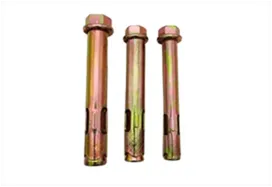Nov . 09, 2024 13:22 Back to list
Threaded Rods for Enhanced Concrete Stability and Structural Integrity
The Role of Threaded Rods in Concrete Applications
Threaded rods are crucial components in various construction and engineering applications, particularly in the realm of concrete work. As construction techniques evolve and the demand for durable and reliable structures increases, the importance of using high-quality materials like threaded rods becomes paramount.
Understanding Threaded Rods
Threaded rods, commonly made from steel or stainless steel, are long, straight bars with helical grooves running along their length. These grooves, or threads, allow for secure fastening with nuts and other accessories, making them versatile anchors in a variety of applications. Their design aids in distributing loads evenly across their threaded surfaces, thereby enhancing stability and strength.
Applications in Concrete
In concrete construction, threaded rods serve a multitude of purposes. They are often utilized as anchor bolts, embedded within the concrete to secure structural elements such as beams, columns, and walls. By anchoring these components, threaded rods ensure that the entire structure can withstand various forces, including tension, shear, and bending.
One of the most common applications of threaded rods in concrete is in the installation of precast concrete elements, like walls and flooring panels. These elements require strong anchoring systems to provide stability during both the construction phase and throughout the lifespan of the structure. By embedding threaded rods into the concrete, contractors can easily secure these elements with nuts or plates, creating a robust connection that is capable of handling heavy loads.
Benefits of Using Threaded Rods
threaded rod concrete

The use of threaded rods in concrete applications offers numerous advantages. Firstly, they provide enhanced flexibility in design. Threaded rods can be cut to specific lengths, allowing for customization depending on project requirements. This adaptability ensures that every connection can be optimized for specific load conditions and dimensions.
Moreover, threaded rods facilitate easier adjustments during installation. If minor modifications are needed after the placement of concrete, the nuts can be tightened or loosened to achieve the desired fit, thereby avoiding the need for extensive procedures to alter the concrete itself.
Threaded rods also improve construction efficiency. They can be installed quickly and easily, enabling workers to complete tasks at a faster pace without sacrificing safety or integrity. This speed is critical in large-scale projects where time is of the essence.
Durability and Corrosion Resistance
The materials used for threaded rods play a vital role in their performance in concrete. For example, stainless steel threaded rods offer superior resistance to corrosion, which is particularly beneficial in environments exposed to moisture or chemicals, such as coastal areas or industrial facilities. Using corrosion-resistant materials prolongs the lifespan of the connections and reduces maintenance costs associated with rust and deterioration.
Additionally, threaded rods can be galvanized or coated with protective finishes to further enhance their longevity. This added layer of protection is essential in ensuring that the threaded rods maintain their structural integrity over time, especially when embedded in concrete, where they are subjected to various environmental conditions.
Conclusion
In conclusion, threaded rods are indispensable in modern concrete applications, providing strength, flexibility, and durability. Their versatile nature allows for a range of uses, from securing precast elements to anchoring structural components. As the construction industry continues to strive for innovative solutions to meet structural demands, the importance of high-quality materials like threaded rods cannot be overstated. Whether in residential, commercial, or industrial projects, the integration of threaded rods into concrete structures is a testament to the evolution of engineering practices aimed at enhancing safety and efficiency.


